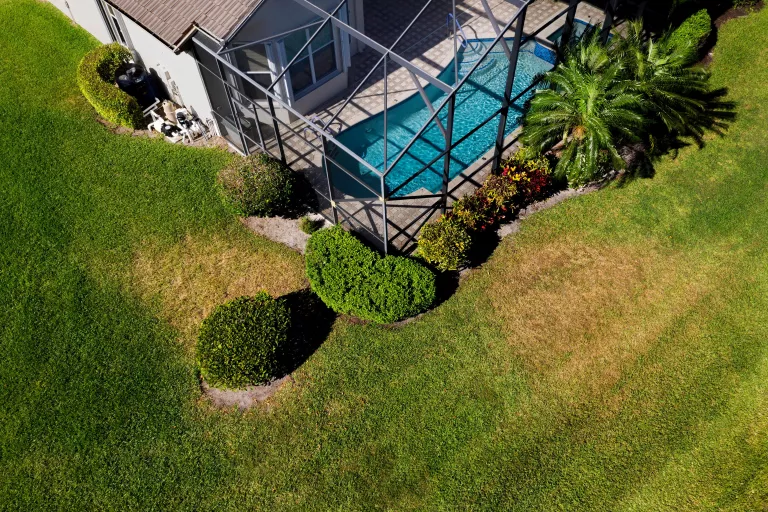When to add lime to lawns – why you may need to and how to do it
Learning when to apply lime to lawns is essential if you want your yard to appear its best.
Your backyard landscaping goals may include establishing a lush, green lawn. Grass maintenance entails various tasks after you’ve mastered the art of planting grass seeds for a perfect lawn.
It is common practice to add lime to lawns to maintain a neutral pH level in the soil. To achieve a healthy lawn, you may need to apply lime, just as you may need to check the pH levels and soil type for various plants to thrive.
Adding lime to a lawn is not the same as fertilizing it; it shouldn’t be treated as such. Besides mowing your yard, you should still know how to aerate it and fix any bare spots in the grass.
This may sound not very easy at first, but it’s relatively easy. Use this guide to apply lime at the proper time, with the right kind of lime, and in the right way.
WHEN TO ADD LIME TO LAWNS

In answer to the question of when to apply lime to lawns, it is only necessary if the soil pH levels are too low.
Soil pH that decreases the availability of nutrients to lawns requires the application of lime.
Soil acidity or alkalinity, measured by the pH scale, is crucial to the well-being of your grass. Turf with a too high or too low pH may seem unhealthy and develop more slowly than it should. Chris Lemcke, national technical director for Weed Man, North America’s most extensive network of locally-owned and -operated lawn care firms, explains that lime is added when a lawn’s soil is overly acidic.
Grass requires a lower pH level in warmer areas, while a higher pH level is preferable in cooler ones, depending on your living hardiness zone.
A pH test can tell if your soil needs to be amended with lime.

WHY DO YOU ADD LIME TO LAWNS?
Lime is often applied to correct pH levels and supply the calcium the grass requires to maintain a healthy lawn. Lime your grass is the best and cheapest way to fix acidic soil. The soil’s acidity is reduced as calcium levels rise as lime decomposes. The nutrients your grass requires will be more easily absorbed in well-balanced soil. Andrew Powell, the proprietor of Garden Centre Shopping, says, “Once you get this going, you’ll see your lawn gradually become thicker and richer in colour.”
Chris adds, “Liming also allows soil bacteria and worms to grow,” creating a productive soil environment rather than a barren one.
The grass will begin to look unhealthy, lose colour, and suffer, and other plants, like moss and weeds, may start to sprout in its place, all of which are telltale signals that it is time to add lime to lawns.
WHAT IS THE BEST MONTH TO LIME YOUR LAWN?
“Fall is typically the optimum time to lime your grass. With this much lead time, Chris says, the lime can neutralize the soil’s acidity before planting season rolls around.
Rain, snow, freezing, and thawing help dissolve the lime into the soil, making autumn the perfect time to accomplish this. Once the warmer months arrive and springtime officially begins, the nutrients will be present for your lawn to develop, Andrew chimes in.
You can also overseed your grass in the fall if you want to.
In contrast, Chris says, “simply don’t lime your lawn during the summer months.” The spring is also a good time to lime your lawn.

WHAT IS THE BEST WAY TO PUT LIME ON YOUR LAWN?
How lime should be applied to a lawn changes the type of lime used.
Wide varieties of lime exist for a variety of purposes. For the most part, dolomitic lime is what you’ll find at garden stores. Dolomitic lime is derived from dolomite, a rock with similar properties to limestone but with higher magnesium and lower calcium content. Since magnesium can be a helpful supplement, it is always suggested that magnesium-rich agricultural grade lime be used instead of plain old calcium-only lime. Turf should never be treated with burnt or hydrated lime. Chris says, “They are overly abrasive.
Lime can be applied in either pellet or powder form; both are equally effective in maintaining a constant soil pH. Chris explains that using a rotary spreader is the most convenient way to spread lime in granular or pellet form.
Powdered lime products should be avoided because of the potential health risks associated with inhaling the powder; instead, use a liquid form of lime and always wear a mask when working with the product. He says that you should have a professional handle the application whenever possible.
Lawns with bare spots are unsightly, so treat the natural grass. Using a pellet spreader, I first make my way down the length of the garden from north to south. Once I’ve gone over the entire lawn, Andrew Powell of Garden Centre Shopping says he’ll do it again, going east to west.
A push mower can also be used to assist spread the lime. Lindsey Hyland, gardening expert and author of Urban Organic Yield, adds, “Be sure to read the guidelines on the lime product you are using, since certain products may require different application methods.

HOW OFTEN SHOULD YOU PUT LIME DOWN ON YOUR LAWN?
If the pH level in your garden is not extremely low, you may be tempted to over-lime the soil.
Every two to three years, a lawn will need to have its soil pH adjusted by adding lime since the pH has dropped below the optimal range of 6.5. There are kits available for home use, or you can get your soil tested at a gardening store. Lindsey Hyland recommends applying a small amount of lime to lawns with pH levels below 6.5 to restore the ideal range and boost the grass’s vitality.
A pH soil tester or kit can be used to determine the soil’s acidity. Neutrality is at pH 7, and the range from 1 to 14 is described. Below-neutral soil is acidic, while soil with a pH above 7 is alkaline. Lindsey points out that most garden centres and some hardware stores sell pH soil testers.







